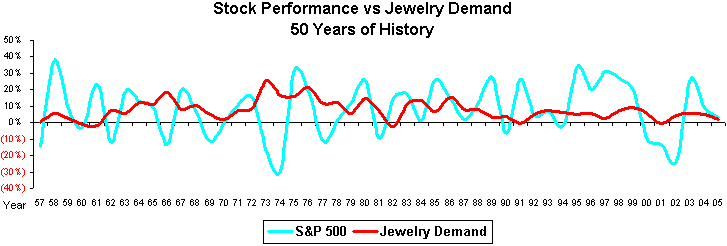IDEX Online Research: Jewelry Stocks Under-Perform in 2005
January 30, 06
U.S. jewelry stocks not only under-performed the major U.S. stock market indices in 2005, but stocks in the IDEX Online Jewelry Stock Portfolio lost money for the year.
However, in part, the averages are deceiving. A couple of stocks were home-runs: Blue Nile and Charles & Colvard posted dramatic gains. Other stocks also made money for investors: Tiffany, LJ International, Aber Diamond, and Movado. However, half of the jewelry stocks in the IDEX Online Jewelry Stock Portfolio lost money for the twelve months ended December 2005.
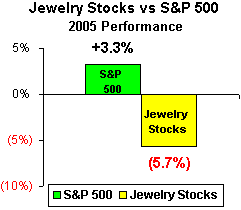 Source: Stock markets |
If investors had purchased the stocks in the portfolio on January 1, 2005, they would have lost nearly $6 on every $100 invested. That represents a decline of 6 percent. If they had owned a portfolio of the S&P 500 stocks, they would have made $3 on each $100 invested, a return of about 3 percent for the year, as the graph at right illustrates.
Stock Performance by Industry Segment Yields Mixed Results
Until the third quarter of 2005, the IDEX Online Jewelry Stock Portfolio had been generally outperforming the market, though the retail segment was weak. However, jewelry stocks significantly under-performed the broad market in the third and fourth quarters due to a variety of factors including valuation issues, worries about consumers’ discretionary spending, and potential economic woes.
By segment, stocks of jewelry suppliers posted strong price gains. Unfortunately, those gains were more than offset by stock price declines among jewelry retailers and internet jewelers. The graph below illustrates stock performance during the year by industry segment – jewelry retailers, jewelry suppliers, and internet jewelers.
 Source: markets |
As the graph illustrates, an investment in jewelry suppliers – Aber Diamond, Charles & Colvard, LJ International, Lazare Kaplan, and Movado – would have returned $22 for every $100 invested, or a whopping 22 percent return.
However, an investment in jewelry retailers – Finlay, Tiffany, Signet, Whitehall, and Zale – would have lost $30 for every $100 invested. Whitehall shares declined about 90 percent during the year. If Whitehall shares had been removed from the index, investors would have lost only $15 for every $100 invested. Stocks of mass market jewelers lost value while the stock of the only high-end jeweler in the group – Tiffany – generated a dramatic +20 percent return for investors.
There was a huge dichotomy between the performances of the stocks of the two internet jewelry retailers in the index. Blue Nile shares soared, while Odimo shares sank dramatically in value.
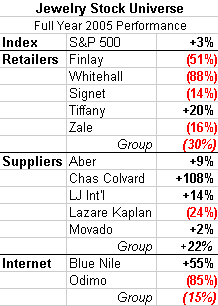 Source: markets |
Stock Performance May Be Related To Questions about Discretionary Spending
Why did jewelry stocks under-perform the broad market for the year? Stock market action is often very difficult to explain. Logic does not prevail. After spending over twenty years on Wall Street, we are still often surprised by stock price action.
The prevailing excuse for the sharp decline in the price of jewelry stocks relates to analysts’ perception that consumers won’t be spending on discretionary goods, both as a result of soaring gasoline prices as well as plummeting consumer confidence related to many factors including potential terrorism, natural disasters, high energy prices, and a host of other shocks – real or perceived, actual or projected – to the system.
On the other hand, smart investors know that luxury demand is rarely affected by external shocks to the system, GDP fluctuations, and other economic indicators such as employment trends.
Based on this “on one hand . . . and on the other hand” reasoning, perhaps most of the stock performance can be explained. For example, on one hand, the stock prices of Tiffany & Co. and Aber rose solidly for the year. Both are involved at the luxury (high-end) of the market. Aber not only sells better quality rough diamonds, but it also owns Harry Winston, a luxury jeweler. Tiffany & Co. operates high-end jewelry stores. On the other hand, the stock prices of most of the mass market jewelers declined. This suggests that Wall Street investors think that high gasoline prices will have a negative impact on spending by mid- and lower-income consumers. Year-to-date through November, jewelry sales in the U.S. are up only a very modest 1.9 percent while total retail sales are up over 8 percent. Clearly, jewelry demand has weakened severely during the year, especially among mass market jewelers, proving that investor perception is correct.
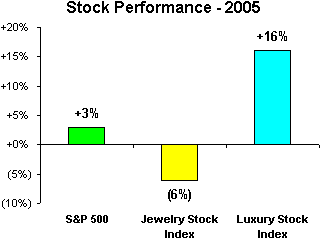 Source: markets |
In addition to under-performing the broad market, jewelry stocks also substantially trailed the performance of major luxury stocks such as Burberry, Richemont, Hermes, and others (Tiffany is also included in this index). While the S&P 500 broad market index was up about 3 percent and jewelry stocks fell by 6 percent as a group, luxury stocks rose about 16 percent as a group. These retailers have also generally been reporting solid sales gains. Once again, it confirms the trend that luxury consumers spend when the mood strikes, rather than in response to economic or other fluctuations.
Long Term View: The Stock Market and Jewelry Demand Does Not Correlate
There are many adages and sayings about the correlation between the stock market and jewelry demand. For example, some people believe that jewelry demand increases when the stock market weakens. The rationale is that consumers look to jewelry as a “store of value.” Unfortunately, research does not support any of these “old wives’ tales.” There is simply no significant correlation between jewelry demand and stock market performance in the U.S., as the graph below illustrates. While the market is particularly volatile (blue line), jewelry demand has been remarkably steady over the past fifty years. It is interesting to note, however, that long term demand trends of jewelry show more modest annual increases in recent years versus solid gains in the “go-go” years in the decade of the 1970s.
|
|
Jewelry Stocks Historically Out-Perform Market
Since the beginning of the decade, jewelry stocks have out-performed the broad market in four of six years, as the graph below illustrates. In 2000, jewelry stock prices plummeted, losing nearly 50 percent of their value, while the broad market was down only 10 percent. However, in the following year, when the market declined again, jewelry stock prices made a dramatic reversal, and were up nearly 40 percent. In 2002, when the market was down about 23 percent, jewelry stocks declined in price by only about 10 percent.
In both 2003 and 2004, jewelry stocks were the place to be – they substantially out-performed the broad market indices. However, in 2005, jewelry stocks declined modestly while the market advanced very modestly. In part, jewelry stock valuations were high at the beginning of 2005. In part, analysts’ evaluation of the consumer’s attitude for jewelry consumption suggested that there are other retail categories which will be more appealing for consumer spending.
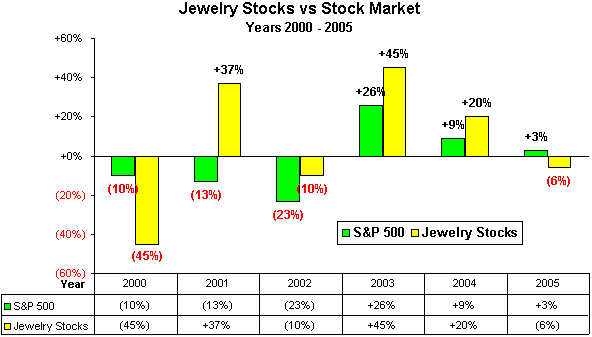
Source: markets
U.S. Stock Market Under-Performs Global Indices
Perhaps another reason for the under-performance of U.S. jewelry stocks is that investors were focused on other markets around the world. When compared to stock market indices for developed countries – France, Germany, Japan, England, and some Asian markets – the U.S. S&P 500 posted the worst performance, as the graph below illustrates.
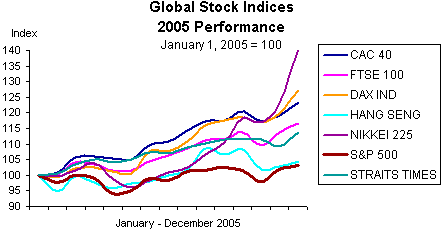
Source: markets
About the IDEX Online Jewelry Stock Portfolio
The IDEX Online Jewelry Stock Portfolio consists of publicly held companies which are tradable on U.S. exchanges. Stocks which sell below $1 are not included. If a stock falls below $1 and remains there, it will be dropped from the portfolio. Likewise, if a “penny stock” rises above $1 and remains there, it will be added to the portfolio. Results for the portfolio are based on buying an equal dollar amount of each stock; much like a typical stockbroker constructs a “balanced, diversified” portfolio. At the end of the period, the results are calculated on an equal-weighted basis. We note, however, that neither of the broad market indices – the Dow Jones and the S&P 500 – are calculated using this method. The Dow Jones is price-weighted, and the S&P 500 is market capitalization-weighted. Both of these methods would require that we would buy and sell shares – sometimes fractional shares – daily to stay in balance. In short, these indices are not strictly comparable to our portfolio, but for our purposes, they are reasonable benchmarks.
In 2006, one stock will be dropped from the IDEX Online Jewelry Stock Portfolio: Whitehall Jewellers. Birks/Mayors and Man Sang Holdings will be added to the portfolio.
Disclaimer: The author owns up to 100 shares of every publicly held retailer in the portfolio as well as some others which are not listed. This allows the author to have access to information which some companies restrict to “shareholders only.”
